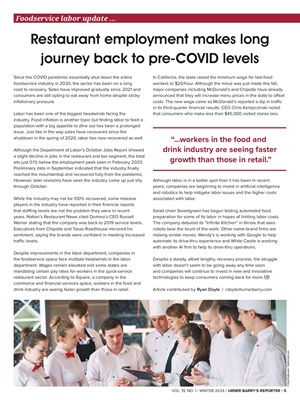
VOL. 19, NO. 1 / WINTER 2024 / URNER BARRY'S REPORTER • 5
Restaurant employment makes long
journey back to pre-COVID levels
Since the COVID pandemic essentially shut down the entire
foodservice industry in 2020, the sector has been on a long
road to recovery. Sales have improved gradually since 2021 and
consumers are still opting to eat away from home despite sticky
inflationary pressure.
Labor has been one of the biggest headwinds facing the
industry. Food inflation is another topic but finding labor to feed a
population with a big appetite to dine out has been a prolonged
issue. Just like in the way sales have recovered since the
shutdown in the spring of 2020, labor has now recovered as well.
Although the Department of Labor's October Jobs Report showed
a slight decline in jobs in the restaurant and bar segment, the total
sits just 0.1% below the employment peak seen in February 2020.
Preliminary data in September indicated that the industry finally
reached the mountaintop and recovered fully from the pandemic.
However, later revisions have seen the industry come up just shy
through October.
While the industry may not be 100% recovered, some massive
players in the industry have reported in their financial reports
that staffing levels are not the problem they were in recent
years. Nation's Restaurant News cited Domino's CEO Russell
Weiner stating that the company was back to 2019 service levels.
Executives from Chipotle and Texas Roadhouse mirrored his
sentiment, saying the brands were confident in meeting increased
traffic levels.
Despite improvements in the labor department, companies in
the foodservice space face multiple headwinds in the labor
department. Wages remain elevated and some states are
mandating certain pay rates for workers in the quick-service
restaurant sector. According to Square, a company in the
commerce and financial services space, workers in the food and
drink industry are seeing faster growth than those in retail.
In California, the state raised the minimum wage for fast-food
workers to $20/hour. Although the move was just made this fall,
major companies including McDonald's and Chipotle have already
announced that they will increase menu prices in the state to offset
costs. The new wage came as McDonald's reported a dip in traffic
in its third-quarter financial results. CEO Chris Kempczinski noted
that consumers who make less than $45,000 visited stores less.
Although labor is in a better spot than it has been in recent
years, companies are beginning to invest in artificial intelligence
and robotics to help mitigate labor issues and the higher costs
associated with labor.
Salad chain Sweetgreen has begun testing automated food
preparation for some of its labor in hopes of limiting labor costs.
The company debuted its "Infinite Kitchen" in Illinois that sees
robots bear the brunt of the work. Other name-brand firms are
making similar moves. Wendy's is working with Google to help
automate its drive-thru experience and White Castle is working
with another AI firm to help its drive-thru operations.
Despite a steady, albeit lengthy, recovery process, the struggle
with labor doesn't seem to be going away any time soon
and companies will continue to invest in new and innovative
technologies to keep consumers coming back for more.
Article contributed by Ryan Doyle | rdoyle@urnerbarry.com
Foodservice labor update …
©David Tadevosian / Shutterstock.com
"...workers in the food and
drink industry are seeing faster
growth than those in retail."